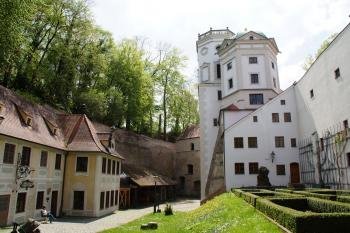
I am pretty sure most people in Augsburg did not realize that the historic water management has the potential for a WHS until it was proposed for the new German tentative list. Other sites in Augsburg were discussed in the past, the Town Hall or the Fuggerei, the world's oldest social housing estate. But after the proposal was submitted, a lot has been done to promote this idea. Since 2013 so-called "Wassertage" (water days) are organized every first Sunday of the month in summer. Several free guided tours to otherwise inaccessible historic water towers and hydropower plants are offered. In June 2013 I had a business meeting in Munich and I took the opportunity to spend the following weekend in Augsburg. I visited the main sites of the nomination: the historic water towers at the Red Gate, the waterworks at the Hochablass and the hydroelectric power plant at the Wolfzahnau.
Augsburg is located on a plateau at the confluence of the rivers Lech and Wertach. The water management in Augsburg began in the Middle Ages. Water from the two rivers and from small streams was conducted through the old town via a network of canals. The water was used for tanneries and dyeing mills, to drive water wheels, to supply the ditches of the city fortification, and to drain off the waste water. Most of the medieval canals have been preserved and make up the charm of the old town, especially in the Lech quarter, the former tanners and craftsmen's district.
In the 15th century, Augsburg was a wealthy trading centre and so the city was able to construct an innovative drinking water supply. Because of the topographic situation - the upper old town is about 20 metres above the river level - the water had to be lifted in water towers. The height of these reservoirs produced enough pressure to transport the water through the water pipes to public wells and private houses. Five of these water towers have been preserved. I took a guided tour to the oldest towers at the Red Gate, an ensemble of three towers and adjacent building around a picturesque courtyard (photo shows two of the towers). The towers have a distinctive shape, the upper floors are octagonal or hexagonal. The tour was very interesting, the guide explained the technical details and the historical development of the water supply. Unfortunately, the technical equipment, the piston pumps and water wheels, is not preserved. But the Maximilian Museum in the city centre shows a large collection of historic models.
The waterworks at the Hochablass weir is another main element of the nomination. In 1879, the water towers were decommissioned and the new waterworks was put into operation. From the outside it looks more like a palace or castle than a technical facility. Today it is still in use as a power plant, but the machine hall is a museum and can be visited (only on special occasions so far). Impressive are the three double piston pumps and the compressed-air vessels. The latter were a technical innovation, they replaced the water towers. The building and the machines are very well preserved, they have been renovated a few years ago including the ceiling paintings and the terrazzo floor. This was my favourite site in Augsburg.
Next to the waterworks is the Augsburg Eiskanal, an artificial white-water river, which was built for the 1972 Summer Olympics as the venue for the canoe slalom competitions. I don't think that it will be part of the nomination, but it was nice to watch a couple of runs.
Finally, I visited the hydroelectric power plant Wolfzahnau north of Augsburg, at the confluence of Lech and Wertach. You have to walk about two kilometres from the parking lot, then you arrive at a beautiful yellow-red brick building dating from 1902. It is privately owned and is still used as a power plant, thus it is open to the public only on special occasions. The historic facilities are partly preserved, for example a huge flywheel generator with five metres in diameter.
The nomination includes a bunch of different sites, which cover a period of almost five centuries of water management: a network of canals in the old town, decorative fountains in the Maximilianstraße, historic water towers and technical facilities for water supply and hydropower. There is an interesting story behind these sites and all buildings are very well preserved. But still a lot has to be done to tell a coherent story and make it comprehensible and visible. At least, the sites must be open regularly.
I was not expecting much from this T-list site, but I was pleasantly surprised, there is more potential than I thought initially. But I must admit, that I like to visit technical and industrial sites.
Comments
No comments yet.
